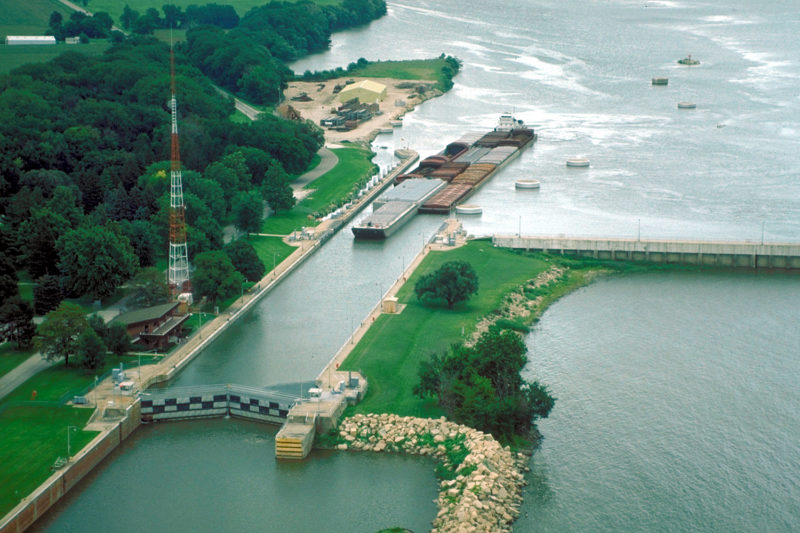The coronavirus pandemic is not expected to disrupt this summer’s lock and dams closures along the Illinois Waterway, the Army Corps of Engineers said.
Shutdowns will occur on schedule from July through October to allow much-needed rehabilitation on five locks of the system, which provides a navigable link between Lake Michigan and the Mississippi River north of St. Louis.
The Corps of Engineers, which runs the project, received the remaining funds needed on April 20, and neither the Corps nor its contractors anticipate any delays — unless Mother Nature throws some curve balls.
“High water could affect construction if it is high enough to get over lock walls and prevent the kind of work that is scheduled.” said Allen Marshall, spokesman for the Corps’ Rock Island District in Illinois. “Delays are possible due to flooding but the timing of the closures was selected because typically flooding is less of a concern during that part of the calendar year.”
All of the locks along the Illinois River have a single lock chamber for passing vessels and are 80-90 years old — well past their lifespans and requiring extensive upgrades.
The consolidated repair project began in 2019 with short closures and will continue this year and in 2023 with longer shutdowns. Closures will be done simultaneously to lessen the impact on commercial navigation, and the Corps says the summer months were chosen to avoid spring flooding and fall harvests.
Depending on the work to be done, closures could last 60-120 days. La Grange Lock and Dam will close from July 1-Sept. 30, Peoria from July 6-Sept. 30, Starved Rock from July 1-Oct. 29, Marseilles from July 6-Oct. 29, and Dresden Island will partially close from July 6-Oct. 3 and Oct. 25-Oct. 28 and fully from Oct. 4-Oct. 24.
During the closures, no vessels will be able to pass through the locks under repair. A possible exception could occur at the LaGrange and Peoria locks should water levels be high enough to allow the wicket portions of the dams to be lowered for open-pass. This would permit vessels to pass around the dam without using the lock. Navigation between the locks on the rest of the river won’t be affected, the Corps said, and both commercial and recreational vessels can navigate within the pools without restriction.
The unprecedented closures present many operational challenges to the barge industry, which has been working with customers along the river for more than a year to develop ways to accommodate commodity movements on this busy waterway.
Plans include using alternative shipping routes and making sure enough barges are available to move products before and after the closures, or to store products during the outages. Barges typically carry farm products, chemicals, ethanol, cement and raw materials for steel mills along the river. About 10 million tons a year of corn and soybeans transit the LaGrange locks.
The closures are also offering opportunities for some barge operators, which is especially welcomed as business slows from declining demand to move products during the pandemic.
Tank barge operators like Kirby Corp. in Houston will be providing barges to store feedstocks and production output from refinery customers along the river during the outages. These barges might otherwise sit idle due to the current weak market conditions for crude oil movements, Kirby CEO David Grzebinski said during the company’s recent first-quarter earnings call. He estimated that 100 barges will be needed for storage this summer.
In addition to tank barges, hopper barges will be needed to transport pet coke produced by refineries located above the locks during the closure as well as steel raw materials and construction aggregates, according to Merritt Lane, CEO of Canal Barge, New Orleans.
Lane said that barges will be needed to move an array of products, including chemicals, edible oils, gasoline components, sand, gravel and stone. He explained that the river will be divided into four or five separate zones for navigation, and since there will be no ability to transit between these zones, each storage barge must be kept in the zone in which the facility it supports is located.
Closures have required “a well-orchestrated plan and is challenging for both shippers and carriers to execute,” he said. “An inevitable impact of the closure is that towboats that typically run along the river will be looking for other things to do during the closure. Harbor services activity will continue but only to the extent of providing localized shifting, fleeting and other services like cleaning and repair.”
Canal’s barges will be working mostly above the Marseilles Lock in the northern part of the river, but this is not new business for them. “It just causes us to deliver the cargo we typically deliver in a different manner as we execute the new logistical plan required by the lock closure,” Lane said, adding that keeping barges busy during the pandemic “could have a more positive impact on overall fleet utilization than we had previously expected.”
Despite the logistical challenges, the barge industry welcomes the closures, regarding them as “the product of successful advocacy efforts to increase federal investment to modernize locks and dams,” Lane said. “The Illinois River locks are among the oldest on the river system and in need of significant refurbishment — as is much of the inland waterways system’s infrastructure. For that reason, we see this closure as a positive development.”
For the latest updates on the outages, consult the Corps of Engineers website.




